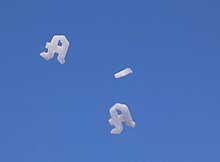Aerial advertising

Under aerial advertising refers to advertising from the air. This is possible with aircraft that are lighter than air, such as balloons and airships - both are inflatables - or with aircraft heavier than air, such as air sports equipment and aircraft .
Advertising lettering

Advertising stickers and paintwork of various types and sizes can be found on countless aircraft, also to finance maintenance costs. Sometimes some hot air balloons are specially made as an advertising figure. Advertising lettering can also be found on hang-gliders , paragliders and even gliders , but above all on airships. Hot air airships , which were developed from hot air balloons, are often manufactured precisely for this purpose.
Airships in particular are very suitable for advertising lettering because of their large dimensions and the low speed inherent in balloons. Alternatively, you can wear neon signs. These are an impressive sight, especially at night, and have occasionally been mistaken for UFOs . The first airship that could project images onto its hull was the Parseval PL 6 as early as 1910 .
Unmanned tethered balloons, light balloons and tethered blimps
Unmanned, tethered airships and balloons also play a major role in aerial advertising. The balloons are 2.5 to 10 meters in diameter and are typically made from either reasonably priced vinyl or better quality polyurethane-nylon. The filling is usually done with helium , less often with combustible hydrogen . A modification of the tethered balloons are tethered airships, which are basically streamlined balloons with stabilizing fins. Manufacturers in Germany are Evolution GmbH in Stockach, Deutsche Inflatable eK in Lübeck, the highly regarded Luftwerbegesellschaft in Munich, the Augsburg balloon factory (which has since been closed) and GEFA-FLUG GmbH from Aachen.
Banner tow
The banner towing attracts a lot of attention at a reasonable cost. A small motorized or ultralight aircraft , and more rarely a helicopter , pulls a tow banner in the aircraft tow . The only problem for the pilot is the start of the banner tow, as the banner either has to be picked up in flight by the so-called catch tow with a tow hook, as is the case with small motorized aircraft, or with microlight aircraft must be started directly with the banner attached. There is also banner advertising with skydiving , the skydiver then pulls a short advertising banner or also a trail of smoke behind him.
The current Guinness world record in banner tow was set on May 1, 2011 at the Nürburgring . A Sikorsky S-76 A ++ helicopter towed a 5,000 m², 1.3 t heavy banner there.
Heavenly writing

Sky writing or engl. Skywriting is a rare but very effective form of aerial advertising. A motorized airplane injects a low-viscosity oil (Marcol 52, among others, has proven itself) into its exhaust system, which evaporates into thick white smoke due to the high temperature of the exhaust gases. The pilot can use appropriate flight maneuvers and precisely timed switching on and off of the smoke system letters, characters and z. B. Create logos or hearts with initials. The decisive factor here is an altitude of at least 3,000 meters, so that the smoke remains visible for many minutes and does not dissipate within a short time, as can be seen in air shows and air races. Wind influences do not play a major role here, as the wind blows evenly at these heights and takes the celestial writing with it as a whole. The pilot can take this into account and apply his writing accordingly. A cloud-free sky or at least a very high cloud base , however, is essential.
Little information can be conveyed with Heavenly Writing. This disadvantage is put into perspective in the age of internet-enabled mobile phones: the URL of a website can be written without any problems. This is how the actual advertising message can be presented.
Flogos

A relatively new form of aerial advertising is the flogo (made up of "flying" or "flying" and "logo"). These are dimensionally stable, individually designed motifs made of foam that rise into the air. In a particular machine is to soap nfluid with water and helium foamed. The resulting stiff foam is pressed through a template, thus shaped in its contour and a layer cut off. Flogos are designed individually and can represent letters, company logos, lettering, numbers or other symbols.
Acoustic aerial advertising
The advertising by means of loudspeaker systems from aircraft, as they were until about 1995 z. B. was practiced on the beaches in Spain, in which aircraft at low altitude broadcast advertising messages from loudspeakers with high volume, has now been banned across Europe.
Advertising through balloon races
Numerous companies organize long-distance flight competitions with commercially available, helium-filled balloons to which the sender's postcards are attached.
Individual evidence
- ↑ Renate Strecker: Record: S-76 hauls 5000 m² banner. (No longer available online.) In: aerokurier online. May 5, 2011, archived from the original on June 16, 2011 ; Retrieved June 16, 2011 . Info: The archive link was inserted automatically and has not yet been checked. Please check the original and archive link according to the instructions and then remove this notice.
- ↑ http://www.flogos.de/
- ↑ http://www.flogoseurope.com/

